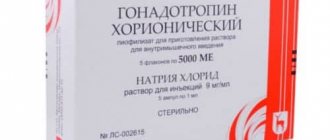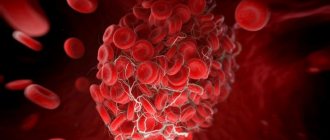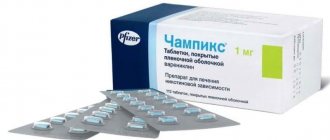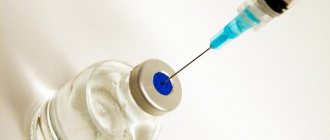| Ribavirin | |
| Chemical compound | |
| IUPAC | 1-[(2 R ,3 R ,4 S ,5 R )-3,4-dihydroxy-5-(hydroxymethyl)oxolan-2-yl]-1 H -1,2,4-triazole-3-carboxamide |
| Gross formula | C8H12N4O5 |
| Molar mass | 244.206 |
| CAS | 36791-04-5 |
| PubChem | 5064 |
| DrugBank | DB00811 |
| Classification | |
| ATX | J05AB04 |
| Pharmacokinetics | |
| Bioavailable | 45% when taken orally on an empty stomach, up to 76% when taken with fatty foods |
| Metabolism | metabolized to 5′-phosphates, de-ribosides and carboxylic deribosidic acids |
| Half-life | 12 days - Multiple Dose; 120-170 hours - Single Dose |
| Excretion | 10% in feces, traces in urine (30% unchanged, traces of metabolites) |
| Methods of administration | |
| liquid for inhalation, capsules and tablets for oral use | |
| Other names | |
| Devirs (cream), Trivorin, Rebetol, Virazol, Ribamidil, Ribapeg, Arviron, Ribavirin | |
| Media files on Wikimedia Commons | |
Ribavirin
(eng. Ribavirin brands:
Copegus, Rebetol, Ribasphere, Vilona, Virazole
) is an antiviral drug for the treatment of severe infections caused by respiratory syncytial virus, viral hepatitis C, as well as other viral infections. Ribavirin is active in the form of a metabolite that has a structure similar to the purine nucleotide guanine.
One of the side effects is dose-dependent hemolytic anemia[1], which in its advanced form causes the death of the patient (and therefore requires total monitoring of blood counts[2] during treatment) [ source not specified 3412 days
]. Ribavirin is also a teratogen in some animals[3].
pharmachologic effect
Ribavirin has a pronounced antiviral effect. It is active against DNA and RNA viruses. The active substance quickly penetrates into cells affected by the virus and is metabolized there. The drug suppresses the division of viral RNA, inhibiting the appearance of new cells. Ribavirin does not have a negative effect on the RNA of healthy cells.
The most sensitive to Ribavirin are influenza A and B viruses, herpes viruses, mumps, parainfluenza, reoviruses, cytomegalovirus and hepatitis C viruses.
Interferon-free therapy: a new era in the treatment of hepatitis C
Much has been said about the reliability of new drugs; this is confirmed by laboratory studies and the conclusions of world-famous infectious disease doctors, and clinical practice. In 95-99% of cases, treatment with sofosbuvir and drugs based on it leads to complete recovery; the virus is not detected in the blood and in control tests, including those carried out several months after cessation of therapy.
The standard regimen involves daily oral tablets for 12-24 weeks. Sofosbuvir was discovered by the global pharmaceutical giant Gilead Sciences and released to the market under the trade name “Sovaldi”; later, affordable generic analogues began to be produced in India, China, and Bangladesh. The drug demonstrates high results in the treatment of any genotype of hepatitis C in combination with other active ingredients.
Study results for patients with stage 4 fibrosis and cirrhosis:
- Duration of treatment is 24 weeks. Sofosbuvir 400 mg/velpatasvir 100 mg without ribivarin - 9% of relapse cases.
- Duration of treatment is 12 weeks. Sofosbuvir 400 mg/velpatasvir 100 mg with ribivarin 12% of relapse cases.
- Duration of treatment is 24 weeks. Sofosbuvir 400 mg/velpatasvir 100 mg without ribivarin - 5% of relapse cases.
According to the data provided, a 24-week course is the most effective and safe, in contrast to treatment of hepatitis C without interferon. Safe because it excludes the use of ribavirin, which is known for its serious side effects. On our website we offer the most effective time-tested products; the assortment always includes Velasof, Sofovir and Daclahep, Ledifos.
According to the results of studies of hepatitis C, it has been proven that unsuccessful therapy leads to mutation of the virus and the formation of its resistance to drugs. This leads to the fact that a treatable disease turns into an incurable one.
Interferon-free therapy is unique in that it does not poison the entire body, and therefore does not cause serious adverse reactions. The patient's quality of life does not change, except that he must take a pill every day at the same time. Direct antiviral drugs are well tolerated, since they do not affect healthy tissue and only work with viral particles.
At the “Unified Generic Pharmacy” you will order the drug necessary for the treatment of any genotype of hepatitis C. The cost of the products is practically no different from the prices in foreign pharmacies. Everyone can purchase the medicine on their own, but it is worth calculating the delivery and remember that in India and Egypt there may be serious problems with issuing a prescription. Prescriptions are not accepted from Russian doctors, and to get one abroad, you need to undergo an examination and be observed by local specialists.
Indications for use
Ribavirin is prescribed for the treatment of chronic hepatitis C (in combination with interferon alfa-2b/peginterferon alfa-2b) in the following situations:
- resistance to monotherapy with interferon alfa-2b and peginterferon alfa-2b;
- exacerbation of the disease after completing a course of monotherapy with interferon alfa-2b and peginterferon alfa-2b;
- no previous therapy with interferon alfa-2b and peginterferon alfa-2b.
Ribavirin
Active substance:
Ribavirin*
Pharmgroup:
Antiviral (except HIV) drugs
Average price in pharmacies
| Name | Manufacturer | average price |
| Ribavirin 0.2 n20 tablet /pranapharm/ | Pranapharm, LLC | 159.00 |
| Ribavirin 0.2 n30 caps /pharmproekt/ | PHARMPROJECT | 112.00 |
| Ribavirin 0.2 n60 caps | OZONE, LLC | 614.00 |
| Ribavirin-lipint 0.5 n6 vial lyophilisate d/susp d/orally | Vector-Medica JSC | 893.00 |
| Ribavirin-sz 0.2 n120 caps | NORTH STAR | 555.00 |
Analogs for the active substance:Arviron Vero-Ribavirin Virazol Devirs Rebetol Ribavin Ribavirin Meduna Ribavirin-LIPINT Ribavirin-FPO Ribamidil Ribapeg Trivorin |
Contraindications
Ribavirin is contraindicated in:
- Renal failure (with CC less than 50 ml/min);
- Diseases of the thyroid gland that cannot be treated with conventional methods;
- Hemoglobinopathies (including thalassemia and sickle cell anemia);
- Severe depression, suicidal thoughts and attempts, incl. in the anamnesis;
- Severe heart diseases (including uncontrolled and unstable forms), as well as within 6 months after their treatment;
- Decompensated cirrhosis of the liver;
- Severe liver failure;
- Autoimmune diseases, incl. with autoimmune hepatitis;
- Hypersensitivity to the drug.
In addition, Ribavirin is not prescribed to children and adolescents under 18 years of age, women during pregnancy and during breastfeeding.
Special observation during treatment with Ribavirin is necessary for:
- Heart diseases;
- Blood clotting disorders, incl. for pulmonary embolism and thrombophlebitis;
- Diabetes mellitus, accompanied by attacks of ketoacidosis;
- Significant inhibition of the hematopoietic function of the bone marrow;
- Severe lung diseases, including chronic obstructive disease;
- Simultaneous use of highly active antiretroviral therapy in patients with concomitant HIV infection.
Dosage and method of administration
As indicated in the instructions for use, Ribavirin tablets and capsules are taken orally with water, without chewing, simultaneously with meals.
Recommended dosage regimen: 800-1200 mg per day, divided into 2 doses (morning and evening), in combination with interferon alfa-2b - 3 million IU subcutaneously 3 times a week or peginterferon alfa 2b - 1.5 mcg/kg subcutaneously once a week.
The daily dose of ribavirin in combination with interferon alfa-2b, depending on the patient’s body weight:
- <75 kg – 1000 mg (400 mg in the morning and 600 mg in the evening);
- ≥75 kg – 1200 mg (600 mg in the morning and 600 mg in the evening).
The daily dose of ribavirin in combination with peginterferon alfa-2b, depending on the patient’s body weight:
- <65 kg – 800 mg (400 mg in the morning and 400 mg in the evening);
- 65-85 kg – 1000 mg (400 mg in the morning and 600 mg in the evening);
- ≥85 kg – 1200 mg (600 mg in the morning and 600 mg in the evening).
Duration of therapy in various categories of patients:
- Previously untreated – 24 weeks or more;
- With hepatitis C virus genotype 1 – 48 weeks;
- Refractory to monotherapy with peginterferon alfa-2b or interferon alfa-2b, as well as in case of relapse - from six months to a year, depending on the clinical course of the disease and response to treatment.
Video about ribavirin
Side effects
This drug increases the risk of birth defects if a pregnant woman takes it. It is also associated with abnormal red blood cell levels.
Ribavirin should not be co-administered with zidovudine due to the increased risk of anemia. Concomitant use with didanosine should also be avoided due to the increased risk of mitochondrial toxicity.
Mechanisms of action
It is a guanosine (ribonucleic) analogue used to stop viral RNA synthesis and limit viral mRNA, thus it is a nucleoside inhibitor. Ribavirin is a prodrug that is metabolized to resemble purine RNA nucleotides. In this form, it interferes with the RNA metabolism required for viral replication. More than five direct and indirect mechanisms have been proposed for its mechanism of action.
RNA viruses
The carboxamide group of ribavirin can make the native nucleoside drug resemble adenosine or guanosine depending on its rotation. For this reason, when ribavirin is incorporated into RNA as a base analogue of either adenine or guanine, it combines equally well with uracil or cytosine to cause mutations in RNA-dependent replication in RNA viruses. This hypermutation can be lethal for RNA viruses.
DNA viruses
Neither of these mechanisms explains the effect of ribavirin on many DNA viruses, which is more puzzling, especially given the complete inactivity of the 2′-deoxyribose analogue of ribavirin, suggesting that the drug functions only as an RNA nucleoside mimic and never as a DNA nucleoside mimic. Ribavirin 5′-monophosphate inhibits cellular inosine monophosphate dehydrogenase, thereby depleting intracellular GTP pools.
Story
Ribavirin was first created in 1972. This was done by researchers from the International Chemical and Nuclear Corporation, including Joseph T. Witkowski and Roland Robins. The drug was reported to be active against a variety of RNA and DNA viruses in culture and in animals without excessive toxicity.
Side effect
Possible side effects of Ribavirin:
- Allergic reactions: erythema, skin rash, urticaria, anaphylaxis, angioedema, erythema multiforme, toxic epidermal necrolysis, bronchospasm, Stevens-Johnson syndrome;
- From the cardiovascular system: increased or decreased blood pressure, rapid heartbeat, tachycardia, bradycardia, cardiac arrest;
- From the respiratory system: otitis media, cough, shortness of breath, bronchitis, rhinitis, pharyngitis, sinusitis;
- From the musculoskeletal system: myalgia, arthralgia;
- Metabolism: dysfunction of the thyroid gland, changes in TSH levels;
- From the genitourinary system: dysmenorrhea, menorrhagia, amenorrhea, decreased libido, hot flashes, prostatitis;
- From the gastrointestinal tract: loss of appetite, dryness of the oral mucosa, nausea, abdominal pain, diarrhea or constipation, vomiting, flatulence, bleeding from the gums, glossitis, hyperbilirubinemia, stomatitis, pancreatitis;
- From the hematopoietic and hemostasis system: thrombocytopenia, leukopenia, hemolytic anemia, granulocytopenia, neutropenia; very rarely - aplastic anemia;
- From the nervous system and sensory organs: general weakness, dizziness, malaise, headache, insomnia, anxiety, irritability, emotional lability, depression, nervousness, asthenia, agitation, confusion, aggressive behavior; rarely - increased smooth muscle tone, conjunctivitis, damage to the lacrimal gland, blurred vision, hypoesthesia, hyperesthesia, fainting, paresthesia, tremor, taste perversion, tinnitus, hearing impairment/loss, suicidal tendencies;
- Other: alopecia, photosensitivity, hair structure disorder, hypothyroidism, thirst, dry skin, flu-like syndrome, chest pain, lymphadenopathy, hyperthermia, sweating, fungal and viral (including herpes) infections, with intravenous administration - pain at the injection site , chills
An overdose of ribavirin may increase the severity of side effects. Hemodialysis is practically ineffective, treatment is symptomatic.
Medical personnel working with the drug may also develop undesirable reactions: headache, bronchitis, otitis media, rhinitis, pharyngitis, itching, swelling of the eyelids, damage to the lacrimal glands, redness of the eyeballs.
Instructions:
Clinical and pharmacological groups
10.001 (Antiviral drug) 10.011 (Antiviral drug for external use)
pharmachologic effect
Antiviral agent. Quickly penetrates cells and acts inside virus-infected cells. Intracellularly, ribavirin is easily phosphorylated by adenosine kinase to mono-, di- and triphosphate metabolites. Ribavirin triphosphate is a strong competitive inhibitor of inosine monophosphate dehydrogenase, influenza virus RNA polymerase and messenger RNA guanylyl transferase, the latter manifested by inhibition of the messenger RNA coating process. These varied effects lead to a significant decrease in the amount of intracellular guanosine triphosphate, as well as suppression of viral RNA and protein synthesis. Ribavirin inhibits the replication of new virions, which reduces the viral load, and selectively inhibits viral RNA synthesis without suppressing RNA synthesis in normally functioning cells.
Most active against DNA viruses - respiratory syncytial virus, Herpes simplex virus types 1 and 2, adenoviruses, CMV, smallpox viruses, Marek's disease; RNA viruses - influenza A, B viruses, paramyxoviruses (parainfluenza, mumps, Newcastle disease), reoviruses, arenaviruses (Lassa fever virus, Bolivian hemorrhagic fever), bunyaviruses (Rift Valley fever virus, Crimean-Congo hemorrhagic fever virus), hantaviruses (hemorrhagic fever virus with renal or pulmonary syndrome) paramyxoviruses, oncogenic RNA viruses.
When treating hemorrhagic fever with renal syndrome, it reduces the severity of the disease, reduces the duration of symptoms (fever, oliguria, pain in the lumbar region, abdominal pain, headache), improves laboratory indicators of renal function, reduces the risk of developing hemorrhagic complications and unfavorable outcome of the disease.
DNA viruses are insensitive to ribavirin - Varicella zoster, pseudorabies virus, vaccinia virus; RNA viruses - enteroviruses, rhinoviruses, Semliki forest encephalitis virus.
Dosage
Individual, depending on the indications, age, regimen, dosage form.
Drug interactions
The possibility of drug or other type of interaction with ribavirin may persist for up to two months (5 T1/2 periods of ribavirin) after discontinuation of its use due to delayed elimination.
When used simultaneously with interferons, the therapeutic effectiveness increases.
When used simultaneously with ribavirin, the effectiveness of stavudine and zidovudine may be reduced.
Use during pregnancy and lactation
Ribavirin is contraindicated for use during pregnancy and lactation (breastfeeding).
Side effects
From the central nervous system and peripheral nervous system: headache, dizziness, general weakness, malaise, insomnia, asthenia, depression, irritability, anxiety, emotional lability, nervousness, agitation, aggressive behavior, confusion; rarely - suicidal tendencies, increased smooth muscle tone, tremor, paresthesia, hyperesthesia, hypoesthesia, fainting.
From the cardiovascular system: decreased or increased blood pressure, bradycardia or tachycardia, palpitations, cardiac arrest.
From the hematopoietic organs: hemolytic anemia, leukopenia, neutropenia, granulocytopenia, thrombocytopenia; extremely rarely - aplastic anemia.
From the respiratory system: dyspnea, cough, pharyngitis, shortness of breath, bronchitis, otitis media, sinusitis, rhinitis.
From the digestive system: dry mouth, loss of appetite, nausea, vomiting, diarrhea, abdominal pain, constipation, taste disturbance, pancreatitis, flatulence, stomatitis, glossitis, bleeding from the gums, hyperbilirubinemia.
From the senses: damage to the lacrimal gland, conjunctivitis, visual impairment, hearing impairment/loss, tinnitus.
From the musculoskeletal system: arthralgia, myalgia.
From the genitourinary system: hot flashes, decreased libido, dysmenorrhea, amenorrhea, menorrhagia, prostatitis.
Allergic reactions: skin rash, erythema, urticaria, hyperthermia, angioedema, bronchospasm, anaphylaxis, photosensitivity, erythema multiforme, Stevens-Johnson syndrome, toxic epidermal necrolysis; with intravenous administration - chills.
Local reactions: pain at the injection site.
Other: hair loss, alopecia, hair structure disorder, dry skin, hypothyroidism, chest pain, thirst, fungal infection, viral infection (including herpes), flu-like syndrome, sweating, lymphadenopathy. Health care workers performing inhalation administration may experience headache, itching, eye congestion, or eyelid swelling.
Indications
For inhalation use: inpatient treatment of infants and young children suffering from severe lower respiratory tract infections caused by respiratory syncytial virus.
For oral administration: treatment of chronic hepatitis C in adults (in combination with interferon alfa-2b or peginterferon alfa-2b).
Parenteral: hemorrhagic fever with renal syndrome.
Contraindications
Chronic heart failure stage IIB-III, myocardial infarction, renal failure (creatinine clearance less than 50 ml/min), severe anemia, severe liver failure, decompensated liver cirrhosis, autoimmune diseases (including autoimmune hepatitis), untreatable thyroid diseases glands, severe depression with suicidal tendencies, childhood and adolescence under 18 years of age, pregnancy, lactation, hypersensitivity to ribavirin.
special instructions
Use only in a hospital setting with a specialized intensive care unit. The use of ribavirin in patients who require mechanical ventilation is only possible by specialists with experience in resuscitation.
Use with caution in women of reproductive age (pregnancy is undesirable), in patients with decompensated diabetes mellitus (with attacks of ketoacidosis), with COPD, pulmonary embolism, chronic heart failure, with diseases of the thyroid gland (including thyrotoxicosis), with blood coagulation disorders, thrombophlebitis, myelodepression, hemoglobinopathy (including thalassemia, sickle cell anemia), depression, suicidal tendencies (including a history), concomitant HIV infection (against the background of combined highly active antiretroviral therapy - the risk of developing lactic acidosis) in elderly patients.
Medical personnel using ribavirin should be aware of its teratogenicity.
Medicines containing RIBAVIRIN
• REBETOL caps. 200 mg: 140 pcs. • VERO-RIBAVIRIN concentrate for preparation. r-ra d/inf. 600 mg/6 ml: amp. 5 pieces. • RIBAVIN caps. 100 mg: 4, 40, 200, 400, 1000, 2000 or 4000 pcs. • DEVIRS® (DEVIRS) cream for external use. approx. 7.5%: tubes of 5 g, 15 g or 30 g • RIBAVIRIN tab. 200 mg: blisters of 10 or 20 pcs., polymer jars of 50, 100, 200, 500 or 1000 pcs., bags of 25,000 or 50,000 pcs. • RIBAVIRIN MEDUNA caps. 200 mg: 100 pcs. • TRIVORIN caps. 400 mg: 12, 18, 21, 42, 60, 120, 150 or 180 pcs. • RIBAPEG® caps. 200 mg: 30, 42 or 60 pcs. • RIBAMIDIL tab. 200 mg: 20, 50, 100, 25,000 or 50,000 pcs. • RIBAVIRIN-FPO tab. 200 mg: 20, 30, 60, 100 or 140 pcs. • RIBAVIRIN tab. 200 mg: 20, 30 or 60 pcs. • VIRAZOL® (VIRAZOLE) concentrate for preparation. r-ra d/inf. 1.2 g/12 ml: vial. 5 pieces. • RIBAVIRIN caps. 200 mg: 30 pcs. • RIBAVIN caps. 200 mg: 4, 40, 200, 400, 1000, 2000 or 4000 pcs. • RIBAVIRIN tab. 200 mg: 20, 30, 60 or 90 pcs. • RIBAVIRIN caps. 200 mg: blisters of 5, 6 or 10 pcs., containers of 10, 12, 14, 18, 20, 30, 40, 50, 60, 100, 120, 140, 180 or 200 pcs. • RIBAVIRIN caps. 200 mg: 30 or 120 pcs. • RIBAVIN-BIO tab. 200 mg: 20 pcs. • RIBAVIRIN tab. 200 mg: polymer jars of 30 or 60 pcs., vial. 30 or 60 pcs. • RIBAVIN-LANS caps. 200 mg: 30 or 60 pcs. • RIBAVIN-BIO caps. 200 mg: 20 pcs. • VERO-RIBAVIRIN caps. 200 mg: 12, 18, 30, 36 or 60 pcs. • RIBAVIRIN-LIPINT® lyophilisate for preparation. suspension for oral administration 500 mg: vial. 1 or 6 pcs. • RIBAVIRIN-FPO caps. 200 mg: 10, 20, 30, 40, 50, 60, 70, 80 or 90 pcs. • TRIVORIN caps. 200 mg: 12, 18, 21, 42, 60, 120, 150 or 180 pcs. • RIBAPEG® tab. 200 mg: 30, 42, 60 or 90 pcs.
special instructions
Medical personnel using ribavirin should be aware of its teratogenicity.
Use only in a hospital setting with a specialized intensive care unit. The use of ribavirin in patients who require mechanical ventilation is only possible by specialists with experience in resuscitation.
Use with caution in women of reproductive age (pregnancy is undesirable), in patients with decompensated diabetes mellitus (with attacks of ketoacidosis), with COPD, pulmonary embolism, chronic heart failure, with diseases of the thyroid gland (including thyrotoxicosis), with blood coagulation disorders, thrombophlebitis, myelodepression, hemoglobinopathy (including thalassemia, sickle cell anemia), depression, suicidal tendencies (including a history), concomitant HIV infection (against the background of combined highly active antiretroviral therapy - the risk of developing lactic acidosis) in elderly patients.
Pharmacological properties
The active compound that is included in Ribavirin is classified as an artificially synthesized nucleoside analogue with antiviral characteristics. The component is characterized by a wide list of viruses that it can fight. The main thing is that their structure suggests the presence of DNA or RNA in the structure.
This substance quickly overcomes the protective barriers created by the virus and enters specific infected cellular structures. Already in the infected part of the tissue, it reacts by phosphorylation with adenosine kinase present inside the cell to mono-, di- and triphosphate analogues. It is these compounds that provide antiviral activity.
The mechanism of these processes has not yet been fully studied. At the same time, we can say with certainty that the drug is able to inhibit inosine monophosphate dehydrogenase, stimulating reactions that lower the level of GTP inside the infected cell.
Such characteristics are optimal for stopping the process of synthesis of viral RNA and individual protein components of the body. In this case, virions that have just formed are not reaction products, and the effect of the virus on humans decreases over time.
Ribavirin can participate in the reactions described above only if the virus contains its own DNA or RNA. But still, human herpes, influenza, paramyxoviruses, reoviruses, oncogenic viruses, poxviruses and Marek's disease virus are most sensitive to the product. The product does not affect smallpox viruses, pseudorabies, enteroviruses, or encephalitis.
The active compound has also been shown to be effective in hepatitis therapy, although the exact reaction pattern has not yet been established. In any case, doctors and biochemists are confident that infected cells are accumulators of decomposition products of this substance, and subsequently they suppress the synthesis of RNA of the hepatitis virus itself.
After taking the tablet, the substance very quickly overcomes the walls of the stomach. Its bioavailability at this moment is almost 50%. Over the course of an hour and a half, the plasma concentration will increase until it reaches its maximum.
This time is an individual characteristic and varies for each patient due to differences in minute blood volume. The average concentration level of this component in plasma is 5 µmol per liter of substance, when measured in patients who completed a weekly course of 400 mg every eight hours.
Ribavirin accumulates not only in plasma, but also in the secretions of the mucous membranes of the respiratory tract. Large quantities accumulate in red blood cells. The maximum concentration will be reached on the fourth day after the start of therapy.
The half-life of distribution is almost four hours. It accumulates in significant quantities in plasma, as well as in cerebrospinal fluid, especially if the course was long. Significant binding to all formed elements of blood is not typical for this substance.
The active component undergoes phosphorylation in liver cells. As a result of these transformations, mono-, di- and triphosphate derivatives are formed, which are subsequently converted into 1,2,4-triazolecarboxamide.
Metabolites and undegraded substances are eliminated for quite a long time. The elimination period for half of the administered portion is two hours from plasma and more than a month from red blood cells. After stopping the course, half of the remaining substance will be excreted for another 300 hours. This happens through the kidneys and intestines.
Interaction with other drugs
When using the drug, it is necessary to take into account interactions with other medications:
- When used simultaneously with interferons, the therapeutic effectiveness increases.
- When used simultaneously with ribavirin, the effectiveness of stavudine and zidovudine may be reduced.
- The possibility of drug or other type of interaction with ribavirin may persist for up to two months (5 T1/2 periods of ribavirin) after discontinuation of its use due to delayed elimination.
Analogs
A direct analogue of the drug is Rebetol - it contains the same active substance and performs the same therapeutic effect. Synonyms for the drug are:
- Arviron - antiviral capsules with the same active ingredient;
- Trivorin - capsules of 200 and 400 mg of the same substance, effective against hepatitis C;
- Virorib is a direct-acting antiviral drug;
- Virazol is a medicine in the form of an ampoule solution;
- Ribamidil - anti-virus tablets;
- Ribapeg – tablets and capsules.
Reviews
We invite you to read the reviews of people who have used the drug Ribavirin:
- Ivan. I have already been taking this drug for two months now, I feel normal, the disease is slowly receding, hepotitis with hepotitis 1
- Vova. I’ve been taking it for about a month (due to meter valve disease, interruptions in extrasystole), the pain in the liver has decreased significantly, I take it with amistin, my heart function has improved a lot, I stopped taking Concor, my mood has improved, pleasant laziness has appeared, my consciousness has cleared up, probably not a normal state of the liver-bile greatly affect the functioning of the heart.
- Alexei. A good drug, helps control hepatitis and generally improves quality of life. It’s a pity that ribavirin has many restrictions on life and it doesn’t suit everyone, then it’s a total disaster, because there are no adequate substitutes for it now








